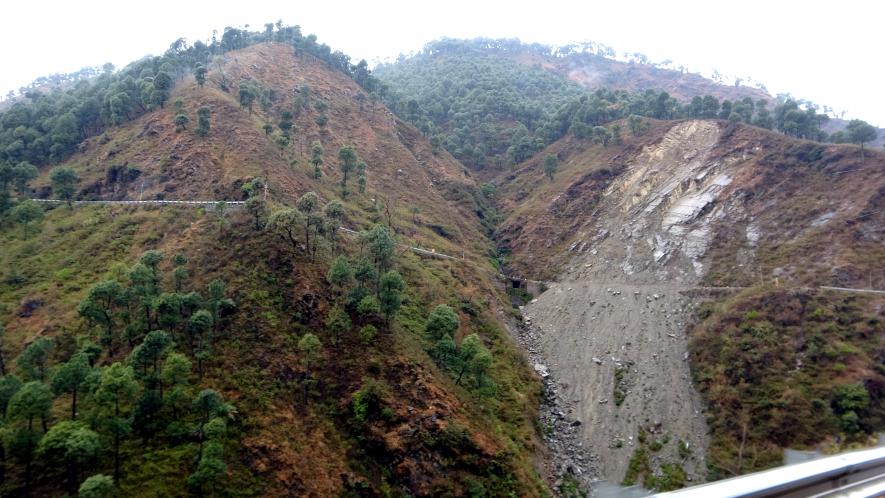Climate Change: Unbridled Development Devastates Ecosystem

Representational image. | Image Courtesy: Wikimedia Commons
Hydro meteorological calamities, including flash floods, cloudbursts and landslides, have killed nearly 6,800 people in the country over the last three years with West Bengal recording the highest number of deaths at 14 per cent.
Providing the details in reply to a question in the Lok Sabha earlier this month, the ministry of home affairs said that such incidents, some of which result in deaths, occur in landslide-prone areas during monsoons.
NATURAL CALAMITIES CAUSING MORE DEATHS
More than 25 bodies have been recovered after a landslide occurred in Nigulsari, in Kinnaur district of Himachal Pradesh, on August 11. A few weeks ago in the mountain town of Dharamshala, vehicles were seen floating in a flash flood triggered by heavy rainfall. Landslides and cloudbursts during monsoons have become common in Uttarakhand.
At least, 110 people were killed in landslides and flooding in Maharashtra last month as heavy rains overwhelmed hundreds of villages and swept away houses. Similar reports of deaths caused by hydro meteorological calamities have been reported from other parts of the country.
The Intergovernmental Panel on Climate Change’s (IPCC) sixth assessment report, released on August 6, reveals the severity of the impact of climate change. Simply put, it means that catastrophic climate-related events are going to occur more frequently with devastating consequences.
Therefore, governments should start strategising immediately to prevent or mitigate such catastrophes. Unfortunately, the intervention made in the guise of development is further impacting people severely or killing them.
REASONS FOR INCREASE IN DISASTERS
The loss of property and human lives due to natural disasters has increased recently, especially in the Himalayas, due to two reasons: the sheer increase in the volume of rainfall during short spells and the arrival of monsoon in dry mountain deserts.
Kinnaur, which was earlier a cold desert patch, has been experiencing more rainfall and less snow due to rising temperatures, triggering frequent landslides.
Apart from the impact of climate change, development work is also affecting the Himalayas, one of the youngest mountains in the world that is extremely vulnerable to massive construction.
In the tribal district of Kinnaur, the government plans to harness nearly 8,000 MW of hydroelectricity. More than 3,500 MW is already being harnessed from this district. Minimum safety standards are bypassed during the construction of these projects. The proposal is to construct hydropower projects right from Khab village, located in the Sutlej river valley near the India-Tibet border, downstream to the Bhakra Dam, which was constructed during the 1960s.
Due to the loss of land in the Himalayas after the construction of large dams, run-of-the-river dam technology was used to construct Nathpa Jhakri Power Corporation Plant (1,500 MW), Wangtoo Karcham Plant (1,000 MW) and Shongtong Karcham Hydroelectric Project (450 MW). A run-of-the-river dam doesn’t hold back water behind it.
Though the land submergence is minimal, the headrace tunnel for creating a potential difference at the surge shaft from where water is supplied to the turbines runs into several kilometres. The construction of these tunnels is hardly done by a tunnel boring machine, which minimises the impact on mountains.
The construction is mainly done by imploding mountains, which disturbs/cracks/fragments the rock layers, leading to massive landslides. The grasslands on these mountains get bereft of natural water flow and become dry. Nathpa village became extinct due to the impact of the construction of the power plant and the villagers had to be relocated.
The widening of roads, especially the construction of four lanes leading to Manali and Kinnaur, has become a nightmare for travellers. The basic norm of cutting mountains—not vertically but using the terrace method— is not followed with a geologist rarely part of such projects. The Parwanoo-Shimla four-lane widening is a reminder of such activity.
These construction activities are neither sustainable nor resilient, and as the IPCC report points out that we must ensure minimum damage to the prevailing ecosystems. However, not more than 6 per cent of funds collected under Compensatory Afforestation Fund Act, 2016, were utilised in the first year. The funds are meant to restore forests lost to development projects.
IMPACT ON URBAN LANDSCAPE
The climate change impact arises from risks that are universally accepted—sea-level rise worldwide, drought, extreme events, food insecurity, increased health risks and temperature-related morbidity in urban environments, etc.
One of the most devastating impacts on cities is the damage caused to urban infrastructure by floods, which ruin millions of livelihoods every year. Cities like Mumbai, Patna and Gurgaon are extremely vulnerable to annual flooding.
One of the reasons aggravating this problem is the project-oriented development strategy of AMRUT and Smart City Missions. Most of the infrastructure laid under these schemes has increased the exposure of cities to floods. The construction of flyovers has disturbed the natural water channels.
According to the UN Sendai Framework for Disaster Risk Reduction, mapping of vulnerability is the first step to minimise the loss caused by climate change. However, this step is hardly followed by consultants of big companies who normally suggest capital-intensive technologies to map such vulnerabilities. Assessing vulnerability through people’s participation is the best method to ensure that loss is minimised.
Not just plans but their proper and strict enforcement is necessary. Resilient strategies for laying infrastructure must be adopted to ensure that there is a minimum loss to the ecosystem.
The sinking of Parali I island in Lakshadweep, the plan to construct a 100-km greenfield ring road parallel to the Little Andaman Island, transfer of tribal forest land to the private coal industry and many such decisions in the recent past show more climate disasters are in the offing. These developments are a reminder that more natural catastrophes will occur unless resilient strategies are adopted.
The writer is the former deputy mayor of Shimla, Himachal Pradesh. The views are personal.
Get the latest reports & analysis with people's perspective on Protests, movements & deep analytical videos, discussions of the current affairs in your Telegram app. Subscribe to NewsClick's Telegram channel & get Real-Time updates on stories, as they get published on our website.
























